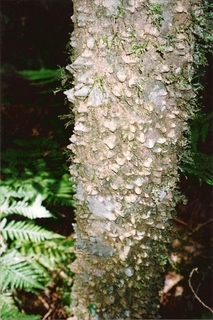Thorny yellow-wood facts for kids
Quick facts for kids Thorny yellow-wood |
|
|---|---|
 |
|
| Trunk at Tooloom National Park | |
| Scientific classification | |
| Genus: |
Zanthoxylum
|
| Species: |
brachyacanthum
|
| Synonyms | |
|
|
The Thorny yellow-wood (scientific name: Zanthoxylum brachyacanthum) is a cool plant found only in north-eastern Australia. People also call it satinwood or scrub mulga. It's part of the Rutaceae family, which also includes citrus fruits like oranges and lemons!
This plant can be a shrub or a tree. It's easy to spot because its trunk has thick, cone-shaped spikes. Its branches also have smaller prickles. The leaves are made up of many smaller leaflets, and its flowers grow in clusters.
Contents
What the Thorny Yellow-wood Looks Like
The Thorny yellow-wood can grow up to 25 meters (about 82 feet) tall. Its branches usually have small prickles. The trunk and older branches have thick, cone-shaped spikes. These spikes make it easy to tell young trees apart in the rainforest.
Leaves and Leaflets
The leaves are "pinnate," which means they look like a feather. Each leaf has seven to thirteen smaller leaflets. A whole leaf can be 120 to 300 millimeters (about 5 to 12 inches) long.
The leaflets are shaped like an egg or an oval. They are 40 to 150 millimeters (about 1.5 to 6 inches) long and 15 to 55 millimeters (about 0.6 to 2 inches) wide. The side leaflets have short stems called "petiolules." The leaflet at the very end has a longer petiolule.
Reproduction and Flowers
The flowers of the Thorny yellow-wood grow in groups called "panicles." These panicles can be at the ends of branches or where the leaves meet the stem. They are usually 15 to 25 millimeters (about 0.6 to 1 inch) long.
Flower Parts
Each flower has four small green parts at its base called "sepals," which are about 1 millimeter long. It also has four greenish-cream colored "petals" that are 4 to 5 millimeters long.
- Male flowers: These flowers have four "stamens." Stamens are the parts that make pollen. They are 3.5 to 8 millimeters long, and their tips (called "anthers") are about 3 millimeters long.
- Female flowers: These flowers have one "carpel," which is the part that develops into fruit. It's about 3 millimeters long and has a short "style" on top. Sometimes, female flowers also have tiny, undeveloped stamens.
Fruit and Seeds
The Thorny yellow-wood flowers from September to November. After flowering, it produces fruit. The fruit is a shiny, bright red pod called a "follicle." It's round or oval, about 7 to 8 millimeters long. As it gets older, the fruit turns dark brown and wrinkled. Each fruit usually holds one black seed inside.
How it was Named
The Thorny yellow-wood was first officially described in 1857. A scientist named Ferdinand von Mueller wrote about it in a science paper. He found the plants in the "Araucaria forests" near a place called Moreton Bay.
Sometimes, you might see another name, Zanthoxylum veneficum. Some experts think it's a different species, especially in Queensland. But others, like the Australian Plant Census, consider it the same as Z. brachyacanthum.
Where it Lives
This tree loves to grow in different kinds of rainforests. You can find it in warm, wet "subtropical" and "tropical" rainforests. It also grows in drier rainforests, often in soil that came from volcanoes.
You can find the Thorny yellow-wood from the Clarence River in New South Wales all the way up to tropical Queensland. It grows in places like Eungella National Park and the Wet Tropics region.
Its Role in Nature
The leaves of the Thorny yellow-wood are an important food source for some butterfly caterpillars. For example, the caterpillars of the Orchard swallowtail butterfly and the fuscus swallowtail love to munch on its leaves. This helps these butterflies grow and develop!
Uses of the Thorny Yellow-wood
This tree has a few interesting uses:
- Ornamental Plant: Because of its cool, spiky trunk, pretty flowers, and nice leaves, the Thorny yellow-wood could be a great plant for gardens or parks.
- Timber: The wood of this tree is a deep yellow color and has a fine grain. This means it could be good for making decorative items or furniture.
- Floyd, A.G., Rainforest Trees of Mainland South-eastern Australia, Inkata Press 1989, ISBN: 0-909605-57-2




